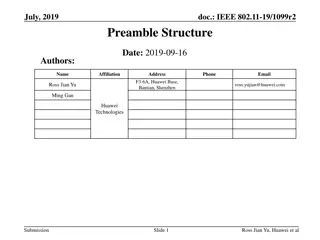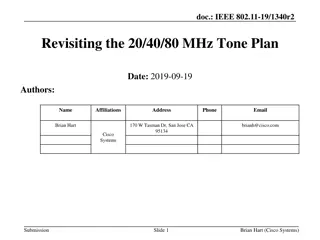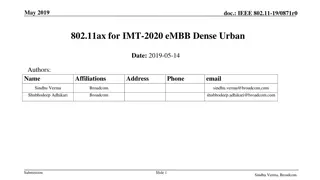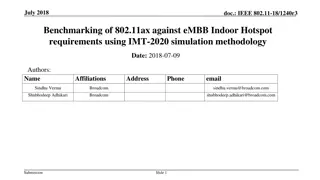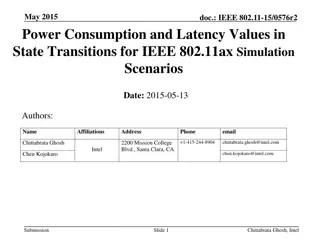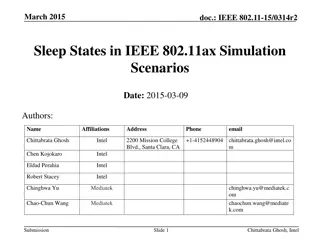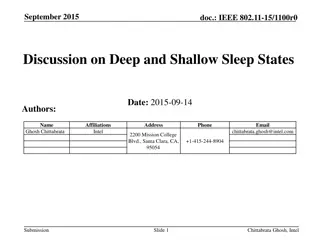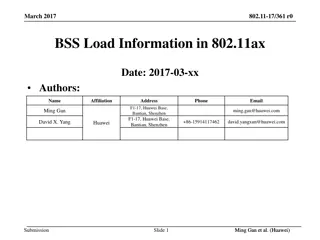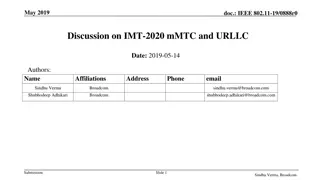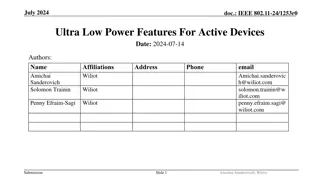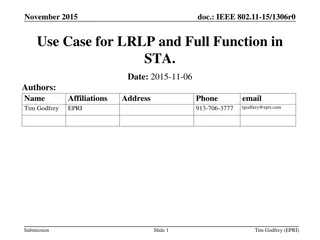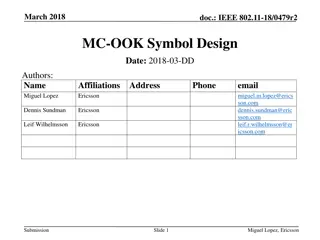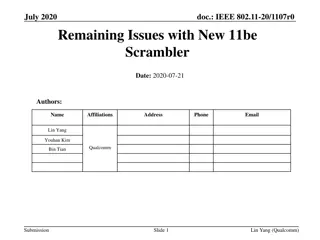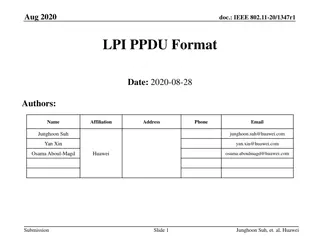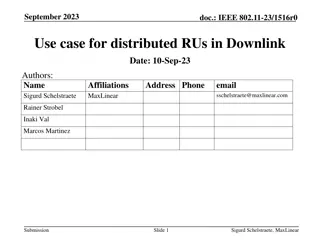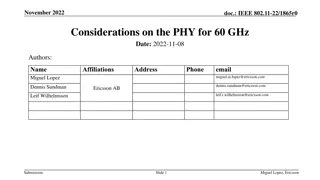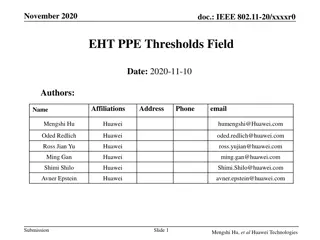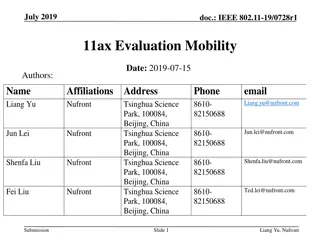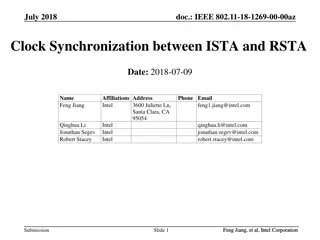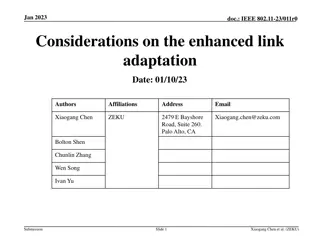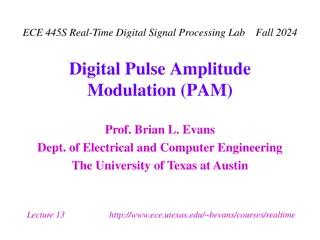IEEE 802.11-15/0099 Payload Symbol Size for 11ax Study
The document dated January 2015 discusses the payload symbol size for 11ax in IEEE 802.11 standards. It includes contributions from various authors representing companies like Broadcom, Intel, Samsung, Marvell, and NTT. The study addresses technical aspects related to wireless communication technologies, particularly focusing on symbol size considerations in the context of IEEE standards.
Download Presentation

Please find below an Image/Link to download the presentation.
The content on the website is provided AS IS for your information and personal use only. It may not be sold, licensed, or shared on other websites without obtaining consent from the author. Download presentation by click this link. If you encounter any issues during the download, it is possible that the publisher has removed the file from their server.
E N D
Presentation Transcript
January 2015 doc.: IEEE 802.11-15/0099 Payload Symbol Size for 11ax Date: 2015-01-12 Authors: Name Affiliation Address Phone email Ron Porat rporat@broadcom.com Matthew Fischer Sriram Venkateswaran Tu Nguyen mfischer@broadcom.com Broadcom Vinko Erceg 2111 NE 25th Ave, Hillsboro OR 97124, USA Robert Stacey +1-503-724-893 robert.stacey@intel.com Eldad Perahia eldad.perahia@intel.com Shahrnaz Azizi shahrnaz.azizi@intel.com Po-Kai Huang po-kai.huang@intel.com Intel Qinghua Li quinghua.li@intel.com Xiaogang Chen xiaogang.c.chen@intel.com Chitto Ghosh chittabrata.ghosh@intel.com Rongzhen Yang rongzhen.yang@intel.com Submission Slide 1 Ron Porat, Broadcom
January 2015 doc.: IEEE 802.11-15/0099 Authors (continued) Name Affiliation Address Phone email Innovation Park, Cambridge CB4 0DS (U.K.) Fei Tong +44 1223 434633 f.tong@samsung.com Maetan 3-dong; Yongtong-Gu Suwon; South Korea hyunjeong.kang@samsung.co m Hyunjeong Kang +82-31-279-9028 1301, E. Lookout Dr, Richardson TX 75070 Innovation Park, Cambridge CB4 0DS (U.K.) +44 1223 434600 1301, E. Lookout Dr, Richardson TX 75070 Kaushik Josiam (972) 761 7437 k.josiam@samsung.com Samsung Mark Rison m.rison@samsung.com Rakesh Taori (972) 761 7470 rakesh.taori@samsung.com Maetan 3-dong; Yongtong-Gu Suwon; South Korea +82-10-8864- 1751 Sanghyun Chang s29.chang@samsung.com 5488 Marvell Lane, Santa Clara, CA, 95054 5488 Marvell Lane, Santa Clara, CA, 95054 5488 Marvell Lane, Santa Clara, CA, 95054 5488 Marvell Lane, Santa Clara, CA, 95054 5488 Marvell Lane, Santa Clara, CA, 95054 5488 Marvell Lane, Santa Clara, CA, 95054 5488 Marvell Lane, Santa Clara, CA, 95054 Lei Wang 858-205-7286 Leileiw@marvell.com Hongyuan Zhang hongyuan@marvell.com Yakun Sun yakunsun@marvell.com Liwen Chu Marvell liwenchu@marvell.com Mingguan Xu mxu@marvell.com Jinjing Jiang jinjing@marvell.com Yan Zhang yzhang@marvell.com Submission Slide 2 Ron Porat, Broadcom
January 2015 doc.: IEEE 802.11-15/0099 Authors (continued) Name Affiliation Address Phone email 5488 Marvell Lane, Santa Clara, CA, 95054 5488 Marvell Lane, Santa Clara, CA, 95054 5488 Marvell Lane, Santa Clara, CA, 95054 5488 Marvell Lane, Santa Clara, CA, 95054 5488 Marvell Lane, Santa Clara, CA, 95054 5488 Marvell Lane, Santa Clara, CA, 95054 1-1 Hikari-no-oka, Yokosuka, Kanagawa 239-0847 Japan Rui Cao ruicao@marvell.com Sudhir Srinivasa sudhirs@marvell.com Saga Tamhane sagar@marvell.com Marvell Mao Yu my@marvel..com Edward Au edwardau@marvell.com Hui-Ling Lu hlou@marvell.com Yasushi Takatori takatori.yasushi@lab.ntt.co.jp Yasuhiko Inoue inoue.yasuhiko@lab.ntt.co.jp NTT Yusuke Asai asai.yusuke@lab.ntt.co.jp Koichi Ishihara ishihara.koichi@lab.ntt.co.jp Akira Kishida kishida.akira@lab.ntt.co.jp 3-6, Hikarinooka, Yokosuka- shi, Kanagawa, 239-8536, Japan yamadaakira@nttdocomo.co m Akira Yamada NTT 3240 Hillview Ave, Palo Alto, CA 94304 watanabe@docomoinnovatio ns.com DOCOMO Fujio Watanabe Haralabos Papadopoulos hpapadopoulos@docomoinno vations.com Submission Slide 3 Ron Porat, Broadcom
January 2015 Authors (continued) doc.: IEEE 802.11-15/0099 Name Phillip Barber Affiliation Address Phone email pbarber@broadbandmobilete ch.com The Lone Star State, TX Peter Loc peterloc@iwirelesstech.com F1-17, Huawei Base, Bantian, Shenzhen 5B-N8, No.2222 Xinjinqiao Road, Pudong, Shanghai F1-17, Huawei Base, Bantian, Shenzhen 5B-N8, No.2222 Xinjinqiao Road, Pudong, Shanghai 5B-N8, No.2222 Xinjinqiao Road, Pudong, Shanghai 10180 Telesis Court, Suite 365, San Diego, CA 92121 NA 303 Terry Fox, Suite 400 Kanata, Ottawa, Canada F1-17, Huawei Base, Bantian, Shenzhen 10180 Telesis Court, Suite 365, San Diego, CA 92121 NA F1-17, Huawei Base, Bantian, SHenzhen 303 Terry Fox, Suite 400 Kanata, Ottawa, Canada 5B-N8, No.2222 Xinjinqiao Road, Pudong, Shanghai Le Liu +86-18601656691 liule@huawei.com Jun Luo jun.l@huawei.com Yi Luo +86-18665891036 Roy.luoyi@huawei.com Yingpei Lin linyingpei@huawei.com Jiyong Pang pangjiyong@huawei.com Huawei Zhigang Rong zhigang.rong@huawei.com Rob Sun Rob.Sun@huawei.com David X. Yang david.yangxun@huawei.com Yunsong Yang yangyunsong@huawei.com Zhou Lan +86-18565826350 Lanzhou1@huawei.com Junghoon Suh Junghoon.Suh@huawei.com Jiayin Zhang +86-18601656691 zhangjiayin@huawei.com Submission Slide 4 Ron Porat, Broadcom
January 2015 Authors (continued) doc.: IEEE 802.11-15/0099 Name Affiliation Address Phone email Laurent cariou Laurent.cariou@orange.com Orange Thomas Derham Wookbong Lee thomas.derham@orange.com 19, Yangjae-daero 11gil, Seocho-gu, Seoul 137-130, Korea wookbong.lee@lge.com Kiseon Ryu kiseon.ryu@lge.com Jinyoung Chun jiny.chun@lge.com Jinsoo Choi js.choi@lge.com LG Jeongki Kim jeongki.kim@lge.com Electronics Giwon Park giwon.park@lge.com Dongguk Lim dongguk.lim@lge.com Suhwook Kim suhwook.kim@lge.com Eunsung Park esung.park@lge.com HanGyu Cho Albert Van Zelst hg.cho@lge.com Straatweg 66-S Breukelen, 3621 BR Netherlands 5775 Morehouse Dr. San Diego, CA, USA 5775 Morehouse Dr. San Diego, CA, USA 1700 Technology Drive San Jose, CA 95110, USA 5775 Morehouse Dr. San Diego, CA, USA 5775 Morehouse Dr. San Diego, CA, USA allert@qti.qualcomm.com Alfred Asterjadhi aasterja@qti.qualcomm.com Bin Tian btian@qti.qualcomm.com Qualcomm Carlos Aldana caldana@qca.qualcomm.com George Cherian gcherian@qti.qualcomm.com Gwendolyn Barriac gbarriac@qti.qualcomm.com Submission Slide 5 Ron Porat, Broadcom
January 2015 Authors (continued) doc.: IEEE 802.11-15/0099 Name Affiliation Address Phone email Hemanth Sampath 5775 Morehouse Dr. San Diego, CA, USA Straatweg 66-S Breukelen, 3621 BR Netherlands Straatweg 66-S Breukelen, 3621 BR Netherlands 1700 Technology Drive San Jose, CA 95110, USA 5775 Morehouse Dr. San Diego, CA, USA 5775 Morehouse Dr. San Diego, CA, USA 1700 Technology Drive San Jose, CA 95110, USA 1700 Technology Drive San Jose, CA 95110, USA 1700 Technology Drive San Jose, CA 95110, USA hsampath@qti.qualcomm.co m mwentink@qti.qualcomm.co m Menzo Wentink Richard Van Nee rvannee@qti.qualcomm.com Rolf De Vegt rolfv@qca.qualcomm.com svverman@qti.qualcomm.co m Sameer Vermani Qualcomm Simone Merlin smerlin@qti.qualcomm.com Tevfik Yucek tyucek@qca.qualcomm.com VK Jones vkjones@qca.qualcomm.com youhank@qca.qualcomm.co m Youhan Kim Submission Slide 6 Ron Porat, Broadcom
January 2015 Authors (continued) doc.: IEEE 802.11-15/0099 Name Affiliation Address Phone email No. 1 Dusing 1st Road, Hsinchu, Taiwan James Yee +886-3-567-0766 james.yee@mediatek.com Alan Jauh alan.jauh@mediatek.com Mediatek Chingwa Hu chinghwa.yu@mediatek.com Frank Hsu frank.hsu@mediatek.com 2860 Junction Ave, San Jose, CA 95134, USA `Thomas Pare +1-408-526-1899 thomas.pare@mediatek.com chaochun.wang@mediatek.co m ChaoChun Wang James Wang james.wang@mediatek.com Mediatek USA Jianhan Liu Jianhan.Liu@mediatek.com Tianyu Wu tianyu.wu@mediatek.com Russell Huang russell.huang@mediatek.com ` Submission Slide 7 Ron Porat, Broadcom
January 2015 doc.: IEEE 802.11-15/0099 Outline The need for larger symbol size for 11ax payloads has been discussed previously Eg: [1] investigated the impact of CFO estimation on symbols with larger FFT sizes (256 and 512 FFT) We have investigated several symbol durations for the payload and propose a new symbol duration We also follow up with a proposal for the choices of CP The proposals are verified via simulations that show Significant Goodput gains over 11ac symbol and CP lengths of 3.2 us and 0.8 us respectively Robust performance in outdoor UL OFDMA Submission Slide 8 Ron Porat, Broadcom
January 2015 doc.: IEEE 802.11-15/0099 Payload Symbol & CP Sizes We propose to replace the current payload symbol duration (3.2 us) with longer symbol duration 12.8 us in order to meet the following 11ax requirements Robustness in outdoor channels Greater tolerance to timing jitter across users in UL MU/OFDMA Higher indoor efficiency (by lowering CP overhead) We also propose the three following CP sizes 0.8 us: 11ac long GI, targeting improved efficiency in indoor settings 1.6 us: percent-wise 11ac short GI, targeting high efficiency in outdoor channels and indoor UL MU-MIMO/OFDMA 3.2 us: percent-wise 11ac long GI, targeting robustness in the more demanding case of outdoor UL MU-MIMO/OFDMA Submission Slide 9 Ron Porat, Broadcom
January 2015 doc.: IEEE 802.11-15/0099 Channel models & implications Outdoor channels UMi-LoS, UMi-NLoS, UMa-NLoS NLoS channels have large delay spreads with significant probability Intersymbol interference leads to high error floors ITU RMS Delay Spread CDF 1 UMi NLOS UMi LOS UMa NLOS UMa LOS 0.9 0.8 0.7 0.8 us CP leads to error floors Need longer CPs 0.6 0.5 0.4 0.3 0.2 0.1 0 0 0.5 1 1.5 2 2.5 [uS] 3 3.5 4 4.5 5 Submission Slide 10 Ron Porat, Broadcom
January 2015 doc.: IEEE 802.11-15/0099 Spectral efficiency Assume a fixed transmission bandwidth and choose an MCS R = code rate, bps = bits/sample (in the frequency domain. Eg. 256 QAM, bps = 8) Nfft = symbol FFT size, Ndata = #data tones/symbol, Ncp = #CP samples 1 ??? ???? ????? ???? ? ??? Spectral Efficiency = 1 ??? 1+ Depends only on MCS Increases as Ncp increases Decreases as Ncp increases Tone utilization As PER decreases for ISI channels Unless we increase Nfft For a given Ncp (dictated by channel length), increase Nfft for smaller overheads and greater spectral efficiency Submission Slide 11 Ron Porat, Broadcom
January 2015 doc.: IEEE 802.11-15/0099 Simulation setup 11ax Payload 11ax-LTF L-STF L-LTF L-SIG Preamble Packet structure Payload 11ax-LTF: 1 symbol, same (FFT size, GI) as payload 11ax-Preamble: 3 symbols, 64 FFT (precise structure undecided now, but # guided by 11ac) How is the preamble relevant? Pilots used for phase tracking, reduce CFO estimation error 1000 bytes FFT sizes: 64, 128, 256 FFT Data tones as defined for corresponding FFT sizes in 11ac CP sizes: 0.8 us, 1.6 us 20MHz bandwidth, SISO, BCC Real processing Channel estimation, timing, frequency offset estimation, phase tracking, phase noise: all real Submission Slide 12 Ron Porat, Broadcom ?
January 2015 doc.: IEEE 802.11-15/0099 UMi-LoS: PER for MCS 0-4 PERs with 1.6 us GI (right figure) smaller than PERs with 0.8 us GI (left figure) Even for a given GI, increasing FFT size reduces PER (ICI corrupted samples is a smaller fraction of the total number of samples) Submission Slide 13 Ron Porat, Broadcom
January 2015 doc.: IEEE 802.11-15/0099 UMi-LoS: PER for MCS 5-9 PERs with 1.6 us GI (right figure) smaller than PERs with 0.8 us GI (left figure) Even for a given GI, increasing FFT size reduces PER (ICI corrupted samples is a smaller fraction of the total number of samples) Submission Slide 14 Ron Porat, Broadcom
January 2015 doc.: IEEE 802.11-15/0099 UMi-NLoS: PER for MCS 0-4 PERs with 1.6 us GI (right figure) smaller than PERs with 0.8 us GI (left figure) Even for a given GI, increasing FFT size reduces PER (ICI corrupted samples is a smaller fraction of the total number of samples) Submission Slide 15 Ron Porat, Broadcom
January 2015 doc.: IEEE 802.11-15/0099 UMi-NLoS: PER for MCS 5-9 PERs with 1.6 us GI (right figure) smaller than PERs with 0.8 us GI (left figure) Even for a given GI, increasing FFT size reduces PER (ICI corrupted samples is a smaller fraction of the total number of samples) Submission Slide 16 Ron Porat, Broadcom
January 2015 doc.: IEEE 802.11-15/0099 Goodput metric used for comparison Goodput = max spectral efficiency obtained by picking the best MCS (for each SNR) ????? ???? 1 ??? ???? Spectral Efficiency = ???[ 1 ??? ? ??? ] max 1+ For a given CP size Ncp, choose largest possible Nfft CP overhead decreases For a given FFT size Nfft , there is a tradeoff in choosing Ncp Small Ncp : small overhead, but PER may be large Large Ncp : PER is small, but overhead large Choose the sweet spot for Ncp Submission Slide 17 Ron Porat, Broadcom
January 2015 doc.: IEEE 802.11-15/0099 Goodput: AWGN Absolute Goodput Goodput relative to (64 FFT, 0.8 us CP) For best results, pick as large an FFT as possible and then pick the smallest CP Increasing CP has no PER benefit in AWGN, increasing FFT reduces overhead Using (256 FFT, 0.8 us CP) gives 1.32x goodput of (64 FFT, 0.8 us CP) Submission Slide 18 Ron Porat, Broadcom
January 2015 doc.: IEEE 802.11-15/0099 Goodput: 11nD Absolute Goodput Goodput relative to (64 FFT, 0.8 us CP) Using (256 FFT, 0.8 us CP) gives ~1.3x goodput of (64 FFT, 0.8 us CP) Since channels have small delay spreads, 0.8 us CP has 6-7% better throughput than 1.6 us CP (256 FFT, around 15-20 dB) Submission Slide 19 Ron Porat, Broadcom
January 2015 doc.: IEEE 802.11-15/0099 Goodput: UMi-LoS Absolute Goodput Goodput relative to (64 FFT, 0.8 us CP) At high SNR Best to use large FFT with longer CP (256 FFT, 1.6 us CP) (256 FFT, 1.6 us CP) gives nearly 2.2x goodput of (64 FFT, 0.8 us CP) At small SNR Thermal noise dominates ISI: increasing CP doesn t give substantial PER gains Stick to smaller CPs, but use larger FFTs: (256 FFT, 0.8 us CP) works best Submission Slide 20 Ron Porat, Broadcom
January 2015 doc.: IEEE 802.11-15/0099 Goodput: UMi-NLoS Goodput relative to (64 FFT, 0.8 us CP) Absolute Goodput Large delay spreads leads to high ISI Best to use large FFT with longer CP (256 FFT, 1.6 us) (256 FFT, 1.6 us CP) gives ~2.5x goodput of (64 FFT, 0.8 us CP) at 25 dB SNR Submission Slide 21 Ron Porat, Broadcom
January 2015 doc.: IEEE 802.11-15/0099 Challenge of UL-OFDMA Timing jitter across users on the UL effectively increases channel delay spread. What is the impact on performance? Impact of intended user delay on himself Impact of delay of interfering users on intended user Sources of timing jitter Different round trip delay Different timing acquisition points due to different channel delay spreads and noise Net timing jitter ~1.3 us (details in Appendix) Submission Slide 22 Ron Porat, Broadcom
January 2015 doc.: IEEE 802.11-15/0099 Simulation setup UL OFDMA with 4 users Each user has one antenna, AP has 4 Rx antenna 20MHz, 256 FFT Each user is allocated a contiguous block of 56 tones. User allocations are fixed, and the second user (middle one) is the desired user (PER/Goodput are calculated for this user) GI values considered: 1.6us, 3.2us ITU UMi NLOS channel 1000 bytes packets Real channel estimation from one LTF Submission Slide 23 Ron Porat, Broadcom
January 2015 doc.: IEEE 802.11-15/0099 Results Interfering users have no jitter For intended user delay of 1.2 us Goodput with 3.2 us GI = 1.16x Goodput with 1.6 us GI Submission Slide 24 Ron Porat, Broadcom
January 2015 doc.: IEEE 802.11-15/0099 Discussion Summary 256 FFT consistently outperforms 11ac symbol duration Goodput gains range from 1.3x-2.5x depending on channel Use 0.8 us CP with 256 FFT for high efficiency in indoor channels Use 1.6 us CP with 256 FFT for greater robustness to long outdoor channels and indoor UL OFDMA/MU-MIMO Use 3.2 us CP with 256 FFT for robust performance in outdoor UL OFDMA/MU-MIMO Why not even higher FFT sizes, say 512 FFT over 20 MHz? Implementation complexities increase with increasing FFT sizes and bandwidths Tones are more narrowly spaced , CFO correction needs to be very precise: challenging task [1] Incremental gain over 256 FFT (3-6% depending on CP size) too small for increased complexity 256 FFT size in 20 MHz seems to be the sweet spot between performance and implementation complexities Submission Slide 25 Ron Porat, Broadcom
January 2015 doc.: IEEE 802.11-15/0099 Proposal We propose that 11ax shall have one longer payload symbol size of duration 12.8 us based on a 256 FFT in 20 MHz And correspondingly 512 FFT in 40 MHz, 1024 FFT in 80 MHz/80+80 MHz and 2048 FFT in 160 MHz We also propose to use the following CP sizes: 0.8 us, 1.6 us and 3.2 us Submission Slide 26 Ron Porat, Broadcom
January 2015 doc.: IEEE 802.11-15/0099 References [1] 11-14-0801-00-00ax-envisioning-11ax-phy-structure-part-ii Submission Slide 27 Ron Porat, Broadcom
January 2015 doc.: IEEE 802.11-15/0099 Straw Poll #1 Do you agree to add to the TG Specification Framework: 3.y.z. Data symbols in an HE PPDU shall use DFT period of 12.8 us and subcarrier spacing of 78.125 kHz. Yes No Abstain Submission Slide 28 Ron Porat, Broadcom
January 2015 doc.: IEEE 802.11-15/0099 Straw Poll #2 Do you agree to add to the TG Specification Framework: interval durations of 0.8 us, 1.6 us and 3.2 us. 3.y.z. Data symbols in an HE PPDU shall support guard Yes No Abstain Submission Slide 29 Ron Porat, Broadcom
January 2015 doc.: IEEE 802.11-15/0099 Appendix Submission Slide 30 Ron Porat, Broadcom
January 2015 doc.: IEEE 802.11-15/0099 UMa-NLoS: PER for MCS 0-4 Submission Slide 31 Ron Porat, Broadcom
January 2015 doc.: IEEE 802.11-15/0099 Goodput: UMa-NLoS Goodput relative to (64 FFT, 0.8 us CP) Absolute Goodput Submission Slide 32 Ron Porat, Broadcom
January 2015 doc.: IEEE 802.11-15/0099 Sources of timing jitter Different round trip delays can contribute 0.6 us (~ 200 m) Timing acquisition on DL can contribute 0.7 us jitter in UMi-NLoS channels. For example, at 10 dB in figure below, 14 samples @ 20 MHz = 0.7 us AP has 4 antennas, STA has 1 antenna Timing acquired from L-LTF Submission Slide 33 Ron Porat, Broadcom


